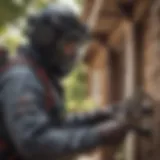Effective Strategies for Catching Chipmunks in Your Yard
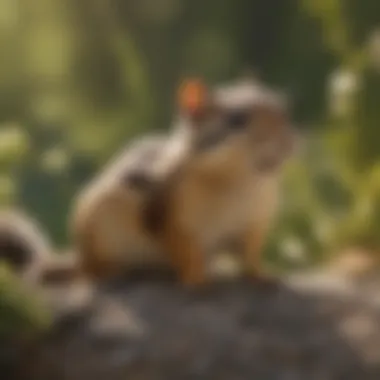

Intro
Catching chipmunks in your yard can feel like you’re caught in a game of cat and mouse, quite literally. These little critters tend to pop up out of nowhere, often leaving homeowners in a bind. However, before you jump the gun and set traps, it is essential to understand the preventive measures that will safeguard your yard and home. This comprehensive guide will navigate through the intricacies of handling chipmunks while promoting humane and environmentally conscious strategies.
Preventive Pest Control Strategies
When it comes to managing chipmunks, prevention is always better than cure. By implementing a slew of preventive strategies, you can minimize the chances of these playful rodents making your yard their home. Let's look at several areas to focus on:
House Exterior Protection
One of the best defenses against chipmunks is a fortified house exterior. Here are some tips to consider:
- Sealing Cracks: Chipmunks are sneaky; they can squeeze into the smallest of openings. You may want to inspect your home for cracks, especially around windows and doors. Use caulk or weather stripping to seal off these entry points.
- Clearing Debris: Chipmunks love clutter, which provides perfect hiding spots. Keeping your yard tidy by clearing leaves, branches, and any piles of mulch will make your property less inviting.
- Preventing Pests from Entering: An effective way to deter chipmunks is to install mesh screens on vents and foundation openings to prevent them from burrowing in.
Yard Maintenance
A well-maintained yard is less likely to attract pests. Here are some essential routines to keep your space pest-free:
- Regular Lawn Care: Mow your lawn regularly and avoid overgrown grass. This also discourages not only chipmunks but other pests too.
- Trimming Shrubs: Keeping hedges and shrubbery trimmed back can make your yard significantly less appealing to chipmunks looking for shelter.
Indoor Cleanliness
It’s not just about the outdoors; keeping your interiors clean plays a crucial role as well. Here are some tips:
- Expert Cleaning Tips: Regularly vacuuming and dusting eliminates food particles that attract pests. Pay special attention to under furniture and appliances.
- Maintaining a Pest-Resistant Indoor Environment: Store food in airtight containers and never leave pet food out overnight. You want to make sure that your space is as unwelcoming to pests as possible.
Garbage Disposal
How you handle your waste can significantly impact pest control. Here are some methods:
- Efficient Waste Disposal Methods: Use garbage cans with tight-fitting lids, and take out the trash regularly to avoid attracting pests.
- Importance of Proper Garbage Disposal: Compost piles should be managed carefully, as they can serve as a buffet for chipmunks and other rodents.
Other Pest Prevention Strategies
There are more innovative ways to safeguard your home from chipmunks and other bothersome pests:
- Using Motion-Activated Sprinklers: Installing these can startle chipmunks away while helping to maintain your garden.
- Employing Natural Deterrents: Plants like lavender or mint can deter chipmunks. Consider incorporating these into your landscape design.
"An ounce of prevention is worth a pound of cure—especially when it comes to pest control."
Identifying Pest Risk Areas
Understanding where chipmunks may enter or thrive in your property is the next step. Inspecting these areas can lead to better prevention strategies.
Moisture Prone Areas Inspection
- Identifying Damp Conditions: Chipmunks are drawn to moist environments. Look for leaking faucets or standing water in your yard.
- Tips for Preventing Infestations: Install proper drainage and eliminate standing water to keep your yard dry.
Crack and Crevice Inspection Guide
- Importance of Inspecting Access Points: Look for gaps in the foundation, where your house meets the ground, or along rooflines.
- Strategies for Sealing Cracks and Crevices: Use appropriate sealants or wire mesh to block potential entry points for chipmunks.
Greenery Inspection for Pest Risks
- Understanding Greenery's Impact on Pests: Inspect not just your garden but trees and large bushes as well.
- Guidelines to Maintain Pest-Free Yards: Regularly trim and inspect your greenery, removing any dead branches or potential nesting sites.
Additional Pest Risk Areas
- Miscellaneous Pest Risk Areas: Don’t forget about areas like compost bins or wood piles. Ensure these are maintained and kept clean to mitigate pest access.
Effective Pest Control Methods
When preventive measures aren’t enough, you may need to look into effective control methods to address chipmunk issues directly.
Natural Repellents for Pest Control
- Safe and Effective Natural Solutions: Essential oils like peppermint and eucalyptus can repel chipmunks safely.
- Use of Essential Oils, Herbs, and Plants: Consider creating a barrier of these plants in your yard to deter chipmunks.
Chemical Sprays for Pest Control
- Safe Usage of Professional Sprays: If needed, ensure that the products you choose are safe for pets and children.
- Eradicating Pests with Chemical Solutions: Use sparingly in areas where chipmunks tend to frequent.
Pest Traps: Effective Pest Control Solutions
- Setting Up and Using Pest Traps: There are various traps that can be set up around the yard.
- Capturing and Removing Pests Safely: Always check traps daily and ensure that captured chipmunks are handled humanely.
Biological Control Methods for Pest Prevention
- Using Natural Predators for Pest Management: Certain animals may deter chipmunks from residing nearby.
- Environmental-friendly Pest Control Techniques: Promoting biodiversity in your yard can help keep pest populations under control.
Other Pest Control Methods
- Innovative Pest Control Methods Beyond Traditional Options: New technologies and products are constantly emerging. Stay updated on the best ways to manage chipmunks effectively.
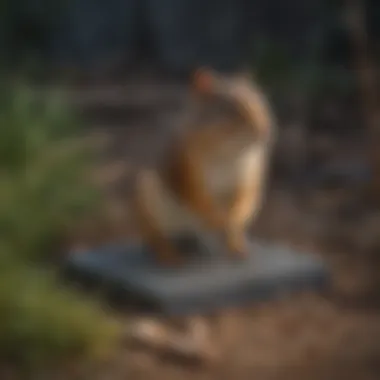
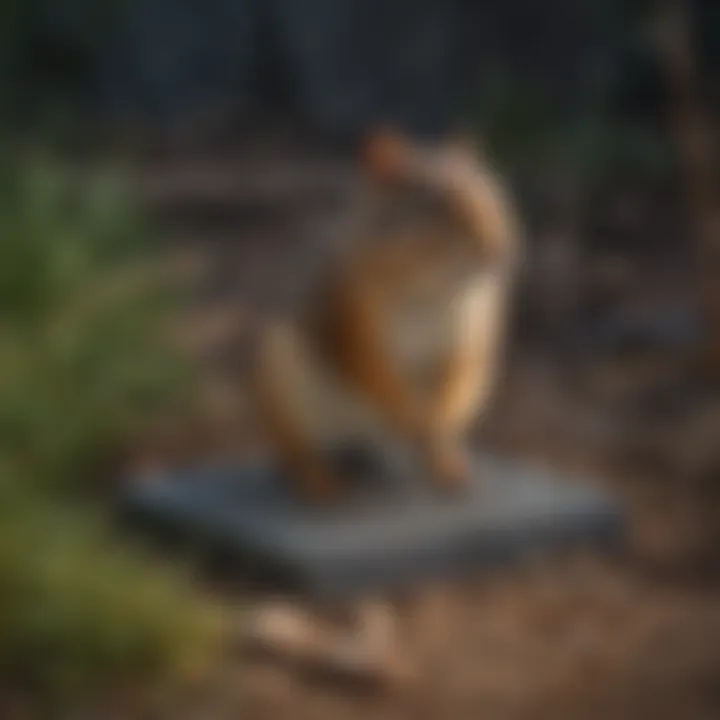
"Keep your pests on their toes, and they might just think twice before moving in."
Pest Species Identification
It's essential to recognize the specific pests you are dealing with as you implement your strategies. Understanding invasions at the species level helps target the right prevention plans.
Understanding Chipmunks
Understanding the characteristics and behaviors of chipmunks is paramount in effectively managing and potentially capturing them. These small mammals, with their playful antics and specialized needs, play a significant role in the local ecosystem. Without grasping their nature and preferences, you might find yourself conducting an uphill battle against them. As we delve deeper into this topic, we unearth essential aspects that will make your efforts both efficient and humane.
Physical Characteristics
Chipmunks are more than just adorable bundles of fur. Typically, they have distinctive features, one being their striped back. These stripes run from their head down to their tails and usually consist of five distinct bands. Most chipmunks measure around 8 to 10 inches in length, including their tail, which is nearly as long as their body. Notably, chipmunks possess cheek pouches that allow them to store food, which they can fill to the brim. This not only aids their survival but also impacts their foraging behavior. Their coloration can vary from light brown to almost grey, depending on the environment, serving as natural camouflage.
Behavioral Traits
Chipmunks are interesting creatures when it comes to their behaviors. They tend to be most active during dawn and dusk, often darting about in search of food. You'll find them collecting seeds, nuts, and fruits, often burying them for later consumption. However, don’t be fooled by their small size; when threatened, they can exhibit quite a remarkable burst of speed.
Understanding their behavior also means recognizing their territory. Chipmunks are territorial creatures, often marking their domain by leaving their scent. This can play a significant role in managing your yard, as knowing where their usual haunts are can help inform trap placement.
One peculiar habit is their chattering vocalizations, often heard when they feel anxious or uneasy. That's their way of warning others of potential dangers. By learning to observe these signals, you can better understand the chipmunks that might be encroaching on your space.
Habitat Preferences
To effectively capture chipmunks, it’s crucial to know their habitat preferences. In a yard setting, chipmunks typically seek out areas with plenty of cover—think dense vegetation, rocks, or garden beds. They favor environments where they can easily dig and create burrows, often in the soil near foundations of homes, patios, or under shrubs.
They are avid climbers too. Trees and fences often serve as pathways for these creatures, allowing them to scout for food while staying out of the line of sight. If you see chipmunks roaming about your garden, it’s likely an indicator that they’ve made a home nearby.
By effectively mapping their habitat, you can take strategic actions to mitigate their presence while ensuring that you respect their essential place in the ecosystem.
"Understanding the habits and preferences of chipmunks is the key to successful management."
Identifying the Problem
Identifying the problem of chipmunk presence in your yard is crucial as it lays the groundwork for effective management of these small mammals. Without a clear understanding of their activity, it becomes challenging to implement appropriate control measures. This stage not only helps in pinpointing the extent of the issue but also informs homeowners about the potential damages and risks involved. After all, prevention is often better than cure, and assessing the situation correctly can save your home from the headaches of further invasions.
Signs of Chipmunk Activity
Chipmunks are creatures of habit, often sticking to routes and patterns that can reveal their presence. Noticing signs of chipmunk activity could be the first step in assessing the extent of your problem. Here are a few key indicators:
- Gardens with Uneaten Fruits or Vegetables: If you find fruits partially nibbled, or vegetables with missing chunks, it’s quite possible a chipmunk or two has been lurking around.
- Daytime Sightings: These critters are typically active during the day. Seeing one scurry across your yard is a pretty solid indication.
- Burrows in the Ground: Look around for small holes in the soil, often placed near plants or garden beds. These burrows are telltale signs that chipmunks are making themselves at home.
- Nuts and Seeds Scattered: If you notice nuts and seeds mysteriously disappearing or being hoarded near a burrow, that’s another big clue.
Keep an eye out for these signs as you stroll through your yard. Noting down their patterns can significantly aid in devising a strategy for catchment.
Assessing Property Damage
Now, let’s talk about assessing the kind of damage chipmunks can inflict. These little animals can wreak havoc if left unchecked. Understanding what they might be nibbling on can help you see the bigger picture.
- Damage to Plants and Bulbs: Chipmunks are notorious for digging up bulbs and munching on roots. A bed full of tulips could become the main course for these critters any day.
- Chewed Wiring: If you live near a wooded area, there's a possibility they'll chomp on any exposed wiring. This not only poses a financial burden in repairs but also raises safety concerns.
- Soil Erosion: Burrows can lead to erosion around your garden. The last thing you want is for your lovingly curated garden to wash away after a rain.
Consider maintaining a log of damaged areas to identify patterns. This log may also help in creating physical barriers in the future.
Understanding Risks
Chipmunks aren't just a nuisance; they can present several risks that need addressing. Being aware of these risks allows homeowners to consider the broader impact of these animals in their yard.
- Disease Transmission: Chipmunks can be carriers of diseases. Their droppings or urine can harbor pathogens that could be harmful to pets or, in rare cases, humans.
- Predator Attraction: If you have chipmunks, chances are other predators—like hawks, snakes, or even neighborhood cats—may be attracted to your yard, which could complicate your outdoor environment.
- Increased Pest Issues: Where there's food and burrowing, other pests may follow. You could find yourself dealing with a variety of unwanted guests, from ants to larger rodents.
In short, identifying the problem isn’t just about noticing an occasional chipmunk. It’s about taking a holistic view of your environment, your property’s value, and placing yourself in a proactive position against any potential threats.
Selecting the Right Equipment
Choosing the right equipment is like laying a sturdy foundation before building a house. In dealing with chipmunks, the efficacy of your methods relies heavily on the tools you select. Not only does the right equipment enhance your chances of a successful catch, but it also influences the humane treatment of these small creatures. So, it's crucial to weigh the options carefully, considering what aligns best with your goals, values, and ethical standards.
Types of Traps
Live Traps
Live traps are an excellent option for those who lean towards humaneness. These traps allow you to catch chipmunks without causing them harm, making them highly suitable for individuals who consider animal welfare a priority. A key characteristic of live traps is that they function on a bait-and-capture principle, enabling you to trap the animal inside without inflicting pain. The unique feature here is the ability to relocate the chipmunk after capture, allowing for a win-win situation—your yard is clear of pests, and the chipmunk is unharmed.
However, there are disadvantages; specifically, you might need to release the chipmunk at a distance deemed appropriate by local laws, and this can take time and effort. Also, if not monitored properly, the trapped chipmunk may suffer from stress or dehydration.
Snap Traps
On the other end of the spectrum, snap traps have long been a popular option due to their immediate catch-and-kill design. These traps are designed to quickly dispatch rodents with little suffering involved. A major advantage of snap traps is their effectiveness and speed. They’re especially useful if you’re facing a significant infestation, as they can be baited and set up in many locations, increasing your chances of success.
That said, snap traps come with their own set of ethical questions. While they can be visually unappealing and could lead to unnecessary suffering if malfunctioning, their decisive nature nonetheless makes them a viable option for some homeowners.
Electric Traps
Electric traps offer a modern twist in the game of catching chipmunks, using a high-voltage jolt to end the rodent's life swiftly. One appealing aspect of electric traps is their requirement for minimal effort once set; you simply place it with bait, and the device does the rest. A unique feature of these traps is that they are often designed for multiple-use, meaning you can keep using them after a successful catch, promoting sustainability.
Still, there are some drawbacks. These traps require batteries, which could be a hassle to manage, and there’s an initial investment cost that might not sit well with every homeowner. It's imperative to ensure proper placement, to avoid accidental captures of non-target species.
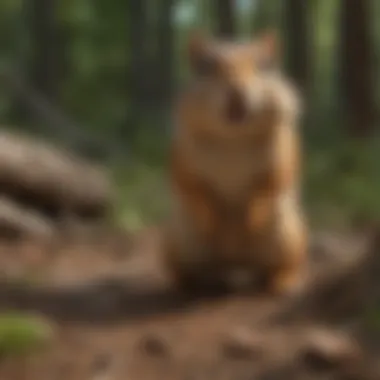
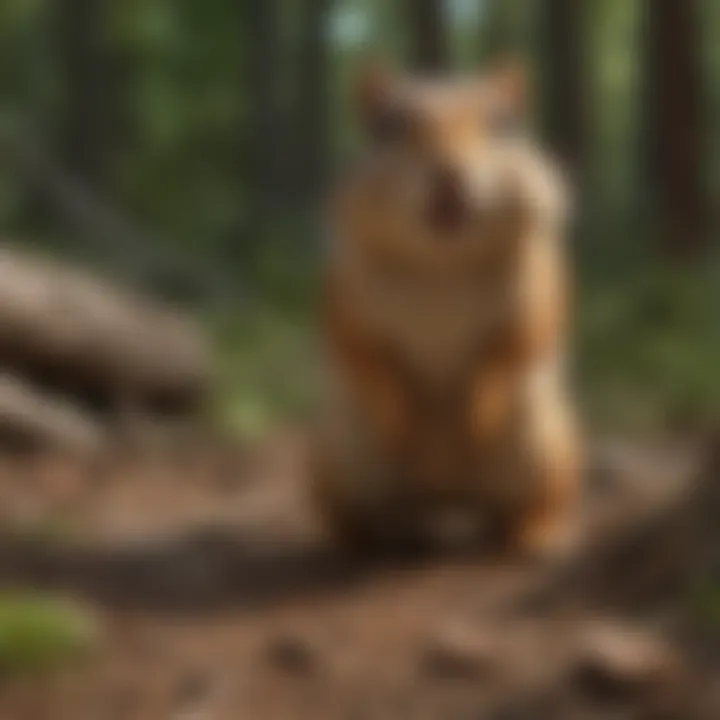
Choosing Bait
Your bait choices can mean the difference between a successful capture and an empty trap. It’s all about enticing those little guys into your traps.
Seed Options
Seeds are often a straightforward bait choice, particularly sunflower seeds. Chipmunks are naturally attracted to them and will eagerly take the bait. This is beneficial because seeds are easily accessible and often inexpensive. However, an important consideration is freshness; stale seeds can be counterproductive, sending the chipmunks running for tastier offerings elsewhere.
Fruit Choices
Similarly, fruits like apples or bananas can be particularly effective. Unlike seeds, fruits give off a strong aroma that can pull in chipmunks from a distance. Yet, the downside is that the fruit may spoil quickly, leading you to check traps more frequently. It's essential to balance your choice with practical maintenance to ensure a successful catch.
Nuts and Grains
Finally, nuts and grains, such as peanuts or corn kernels, are irresistible to chipmunks. They not only provide a delightful snack but can also last longer than fruits. However, be cautious about the potential for attracting other wildlife, like squirrels, which might also interfere with your traps. Selecting the right bait can make a huge difference in your trapping efforts.
This comprehensive approach not only allows for an effective catch but also aligns with an ethical standpoint, ensuring that your methods are as responsible as they are effective.
Setting Up Traps
Setting up traps is a critical step when it comes to addressing chipmunk issues in your yard. This phase is not merely about placing a trap; it encompasses thoughtful planning and strategic execution. The right approach increases your chances of successfully catching these little critters while being considerate of their welfare.
When you think about traps, it’s easy to imagine something significant and complex, but fundamentally, it’s about creating an environment that lures chipmunks in. Select a trap that aligns with your ethics as well. If you favor humane methods, live traps can be beneficial. Their effective design allows for a catch without harming the animal.
Location Strategies
Choosing the right location is akin to fishing—casting your line where the fish are likely to swim increases your catch rate. Chipmunks usually follow well-trodden paths. Therefore, you should observe your yard for areas of high activity. Look for:
- Burrows or nests: These are often close to food sources.
- Feeders or gardens: Chipmunks love seeds and fruits, so positioning traps near sources of attraction can help.
- Shade or cover: Since chipmunks can be skittish, setting traps in areas with some protection can entice them closer to the trap.
In addition to physical placements, minding the direction of sunlight is important too. Avoid placing traps in overly sunny spots, which might deter the animals. Try keeping them in the shade to create a chill vibe—something less intimidating for our furry friends.
Timing Considerations
Timing is another vital element that can not be overlooked. There are certain windows when chipmunks are more active and these insights can aid you in making the right move. Consider the following:
- Early morning and late afternoon: Chipmunks tend to forage during these cooler times of the day.
- Seasonal changes: Spring and summer are typically busier seasons for these critters. They’re preparing their nests or gathering food for winter, so they might be easier to spot.
- Weather conditions: After a rain, chipmunks might venture out more, as food might be more accessible.
Setting traps overnight can also be strategic. Chipmunks are more likely to enter traps when they’re less wary and feel safe under the cover of darkness. Just ensure to check your traps early in the morning to avoid unnecessary stress for the animal.
In summary, setting up traps is a methodical process that requires attention to detail and a consideration of the chipmunks’ behaviors and habits. By thoughtful planning for trap locations and timings, you increase your chances of effective and ethical management of chipmunk populations in your yard.
"Proper planning is half the battle won; set your traps wisely to ensure success in your chase for a critter-free environment."
With careful preparation, your trapping efforts can lead not just to successful captures but also to greater harmony with the wildlife around your property.
Humane Catching Techniques
When it comes to catching chipmunks in your yard, adopting humane techniques is not just a trend, but a necessity that aligns with ecological responsibility and ethical considerations. Many homeowners find themselves grappling with chipmunk nuisances, yet implementing humane methods is a conscious choice reflective of compassion towards all creatures. The importance of humane trapping goes beyond simply solving a problem; it fosters a respect for wildlife, ensuring that their lives are treated with dignity even amidst unfortunate circumstances.
Moreover, humane capturing techniques can mitigate any potential backlash from neighbors or local wildlife enthusiasts. More often than not, when guidelines for humane traps are followed diligently, it establishes a good rapport within the community. An essential point is that humane traps not only capture chipmunks without harm but can also reduce the risk of injury to pets and other non-target species. In the long run, these practices display a commitment to ethical wildlife management. Different humane catching methods can include various types of traps, such as live traps, which allow for the safe capture and subsequent release of chipmunks.
Ethical Considerations
Delving into ethical considerations, it’s paramount to reflect on the creatures being caught. A significant aspect of this is the respect for life; chipmunks, while often labeled as pests, have their place in nature. Ethical trapping means ensuring that any method used does not inflict undue suffering.
- Consider the trap’s design; select those that are specifically designed for the safe capture of small mammals.
- Always avoid methods that lead to injury or distress to any animal. Following guidelines—as directed by organizations like the Humane Society—enhances understanding of proper practices.
- Think about the stress involved for the animal. Traps should minimize fear and anxiety; this can mean opting for quieter mechanisms and traps with enough space for the animal to feel secure.
Understanding the local wildlife laws is crucial, as regulations often exist to ensure the well-being of various species. Following these laws demonstrates a commitment to responsible behavior.
Releasing Chipmunks Safely
Once chipmunks have been trapped humanely, the next step plays a prominent role in the overall wellbeing of these creatures: safe release. Releasing chipmunks can be a delicate matter. Here are several guidelines for ensuring a smooth transition back into their natural habitat:
- Choose the Right Environment: Release chipmunks at a suitable distance from your home, preferably in areas that supportive of their survival, like wooded spots or natural parks. A site that has ample food sources and shelter will help them thrive.
- Timing is Key: Ideally, release during the cooler parts of the day—mornings or evenings—to avoid stressing the chipmunks. Hot weather can pose a danger, making them more vulnerable right after capture.
- Observe Local Regulations: Some regions have specific rules regarding where and how wildlife can be released, so familiarizing yourself with these can prevent unwanted consequences.
- Be Considerate of Others: Inform any nearby residents or property owners about your plans, especially if releasing in an area they may frequent.
When you practice ethical and humane capturing, it's more than a responsibility; it becomes a part of living in balance with nature and your community.
In essence, the approach to humane capturing and releasing chipmunks isn't merely about solving an immediate issue—it’s about building an ongoing relationship with the environment and its inhabitants.
By incorporating these humane methods, you become a steward of wildlife, creating a harmonious living space that reflects respect for all beings involved.
Post-Capture Management
Once you’ve successfully captured chipmunks, it’s crucial to manage the aftermath thoughtfully. Post-capture management significantly influences not only the well-being of these creatures but also the effectiveness of your long-term yard management strategies. Understanding what to do after the traps are sprung leads to improved outcomes for both your landscape and the local ecosystem.
Inspection for Nesting
Following capture, the first step in your management journey is inspecting for nesting locations. Chipmunks are notorious for building hidden nests, generally in burrows or crevices near food sources. By checking for nests, you can determine if you may have left any stragglers behind. This is particularly important because a lone chipmunk can repopulate quickly if not adequately managed.
Look for signs like small holes in the ground or fresh dirt mounds, where chipmunks typically dig. Another indication can be the presence of chewed nuts or seeds in close proximity. Identifying these nests ensures that any future strategies for deterrence or removal are well-informed. Not to mention, by being aware of their nesting habits, you can take necessary measures to safeguard your yard against any more unwelcome guests.
Preventing Future Invasions
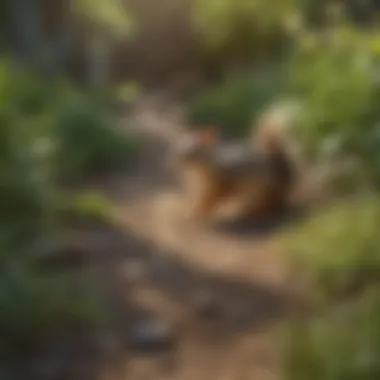

Preventing future invasions requires proactivity and strategic adjustments to your yard’s environment. With chipmunks, it’s often about changing how they perceive your space—a little like adjusting the welcome mat, just not the kind they’ll want to wipe their feet on.
Environmental Modifications
Environmental modifications play a significant role in deterring chipmunks. By changing the landscape to be less appealing, you reduce the likelihood of their return. For instance, keeping your garden tidy and clearing away fallen fruit can hamper their food sources. Additionally, reducing cover like dense shrubbery or tall grass can expose them to predators, further discouraging their habitation.
The key characteristic of environmental modifications is its simplicity and effectiveness. You don’t have to spend a fortune or labor through elaborate construction to achieve results. Instead, gradual changes in your yard's layout can significantly deter chipmunk nests. This method is often celebrated for being sustainable—as it encourages a balanced ecosystem without heavy reliance on traps or other interventions.
However, an important consideration is that some modifications may affect other wildlife interactions. Ensuring that your environment remains inviting to beneficial species might require a careful balance.
Physical Barriers
Another effective measure to hinder chipmunks is through the use of physical barriers. These barriers can take on various forms, from fence installations to planting certain types of hedges. The essential thing to keep in mind is that the barrier needs to be sturdy enough to withstand digging or climbing.
Fencing made of wire mesh, sunk about a foot into the ground, creates a slowing, if not stopping, effect for these small critters. A distinctive feature of physical barriers is their reliability once properly installed. They act as a long-term solution compared to temporary traps. Many homeowners find peace of mind in knowing that a strong barrier can protect their garden over time.
Nonetheless, it’s essential to recognize that physical barriers require an initial investment of resources, labor, and careful planning to ensure that they are effective. Plus, improper installation can lead to gaps that chipmunks might exploit, undermining the very objective you aim to achieve.
Effective post-capture management requires understanding chipmunks' behaviors and environmental needs.
Ensuring that the landscape is modified for deterrence and relying on robust physical barriers creates a comprehensive strategy against any chipmunk invasions. Together, these approaches can lead to sustained success in maintaining your yard as a chipmunk-free zone.
Environmentally Responsible Practices
The care we take with our environment significantly shapes how we manage wildlife around our homes. A critical aspect of catching chipmunks is not just about removing them but doing so in a way that respects their role in the ecosystem. These little critters aren’t merely pests; they contribute to soil health by aiding in seed dispersion and provide food for various predators. Consciously navigating their presence helps maintain that delicate balance in nature that keeps our gardens thriving.
Understanding Ecosystem Roles
Chipmunks, while seen as nuisances by many homeowners, play a notable part in their surroundings.
- Soil Aeration: By digging and burrowing, these animals help aerate the soil, promoting healthier plant growth.
- Seed Dispersers: They cache seeds in various places, which, when forgotten, can sprout into new plants. This creates a natural rhythm of growth and decay within the ecosystem.
- Prey for Predators: Chipmunks serve as prey for a range of predators, helping to sustain the local food chain.
Understanding these roles can shift your perspective from merely wanting to get rid of them to finding more harmonious solutions. As responsible homeowners, we must consider how our actions influence the larger picture. Instead of viewing chipmunks simply as pests, think of them as a part of the wildlife that keeps our yards vibrant.
Long-term Control Strategies
To effectively manage chipmunks in the yard, a mix of short-term measures and long-term strategies can create a significant impact. A holistic approach not only mitigates current issues but also prevents future invasions effectively.
- Habitat Modification:
- Behavioral Changes:
- Encourage Natural Predators:
- Trim back overgrown plants and remove excess debris to eliminate potential nesting sites. This doesn’t just deter chipmunks but also reduces habitats for other unwanted pests.
- Adjusting your landscaping can also help. Implementing physical barriers like fences can deter curious critters from making themselves at home.
- Change feeding habits. If you often leave pet food or birdseed outside, consider doing so less often or in ways that make it more difficult for chipmunks to access.
- Regularly clean up fallen fruits or seeds around your garden, as this can reduce food sources.
- By fostering an environment where natural predators like hawks or owls feel welcome, you can naturally keep chipmunk populations in check.
"Every action creates a ripple effect, consider the interconnectedness of life and make choices that support balance."
Legal and Ethical Regulations
When it comes to managing chipmunk populations in your yard, understanding legal and ethical regulations is of utmost importance. These regulations not only safeguard the wildlife but also protect homeowners from inadvertently stepping into a legal quagmire or facing unforeseen consequences. Managing wildlife, including chipmunks, isn't just about having the right traps or bait; it’s also crucial to approach the task in a manner that respects local wildlife laws and community standards.
Local Wildlife Laws
Navigating local wildlife laws can feel like walking through a minefield, especially if you're unfamiliar with them. Each state or locality may have its own set of regulations regarding trapping and handling wild animals. Here are some common points to consider:
- Trapping Restrictions: Many areas have specific guidelines on which types of traps can be used. Some jurisdictions may limit the use of certain traps or even prohibit them altogether. It’s wise to check with local wildlife authorities.
- Permits Required: In some regions, a permit may be necessary to trap or relocate wildlife. Ensure that you understand the application process and legalities involved.
- Species Protection: Chipmunks may not be considered a threatened species, but nearby wildlife might be. Understand the laws that protect endangered species before deciding to trap.
- Local Guidelines: Local municipalities might put additional regulations on how animals should be handled once captured. For instance, releasing animals should be done in a manner that keeps both them and the community safe.
Not knowing these regulations can lead to hefty fines or penalties. Therefore, one should always check local resources or government websites to get the latest updates on local wildlife laws.
Best Practices in Wildlife Management
When managing wildlife, a few best practices can help ensure the approach is ethical and responsible:
- Educate Yourself: Before taking any action, familiarizing oneself with the practices of humane wildlife handling can make a world of difference. Wildlife recovery organizations and local conservationist sites offer resources that can boost understanding of these concepts.
- Humane Trapping: If trapping is necessary, opt for humane traps that do not cause undue stress or harm. These traps allow for live capture, enabling the chipmunks to be released unharmed in suitable areas far from your property. This reflects both an ethical stance and compliance with many local laws.
- Handling After Capture: Whether you plan to relocate or simply release the animal, it is crucial to handle it with care. Stress is a significant factor that can impact an animal's survival. Observing best practices can ensure they thrive post-release.
- Monitoring Effectiveness: After you’ve gone through the process of trapping, it's wise to monitor the area for any signs of further chipmunk activity. Keeping tabs on the situation helps in making more informed decisions in the future.
Ultimately, knowing and adhering to these ethical regulations not only enriches your own understanding of environmental responsibility but also ensures your methods are both legal and humane.
"Responsibility is the price of freedom."
Choosing to follow these regulations keeps you well within legal boundaries while demonstrating respect for wildlife. All these factors contribute to a more harmonious coexistence between humans and nature.
Finale
Navigating the challenges of managing chipmunks in your yard may seem daunting at first, but understanding the strategies laid out throughout this article equips homeowners with the necessary tools for a successful and ethical approach. The conclusion synthesizes the key elements discussed while emphasizing not only efficiency but also compassion towards these small creatures that share our outdoor spaces.
Summary of Key Points
To recap, several strategies have been outlined:
- Understanding Behavior: Recognizing chipmunks' habits aids in successful trapping. Their tendencies to forage and store food can give valuable insights into their movements.
- Choosing the Right Equipment: Selecting appropriate traps, such as live traps or snap traps, and knowing the best bait are critical steps that enhance capture rates.
- Humane Techniques: It's vital to consider the ethical implications of trapping and to learn safe ways to release chipmunks post-capture.
- Post-Capture Management: Inspecting your property for nests and setting up barriers are effective long-term solutions.
- Legal Considerations: Understanding local wildlife laws ensures that your actions comply with regulations, which protects both you and the chipmunks.
These points not only streamline the process of managing chipmunks but also reflect a commitment to balance between human needs and nature's ecosystem.
Future Considerations
Looking ahead, one must ponder not just the immediate impact of chipmunks in your yard but also how your choices shape your environment. Here are several considerations:
- Ongoing Monitoring: Regularly observe the yard after implementation of practices to ensure the effectiveness of your chosen traps and strategies.
- Community Awareness: Engaging with neighbors and local wildlife organizations can provide additional support and may yield new tips on coexistence.
- Adaptability: Chipmunks can adapt to various methods over time. Staying educated about their behavior and modifying strategies as needed is important for sustained success.
- Broader Ecosystem Dynamics: Recognizing that every action contributes to the larger environmental picture can foster a deeper understanding of wildlife management.
By keeping these insights in focus, homeowners can develop a proactive approach toward managing chipmunks, ultimately leading to a harmonious coexistence that respects wildlife while protecting personal spaces. Remember that ethical practices today pave the way for a balanced future.


